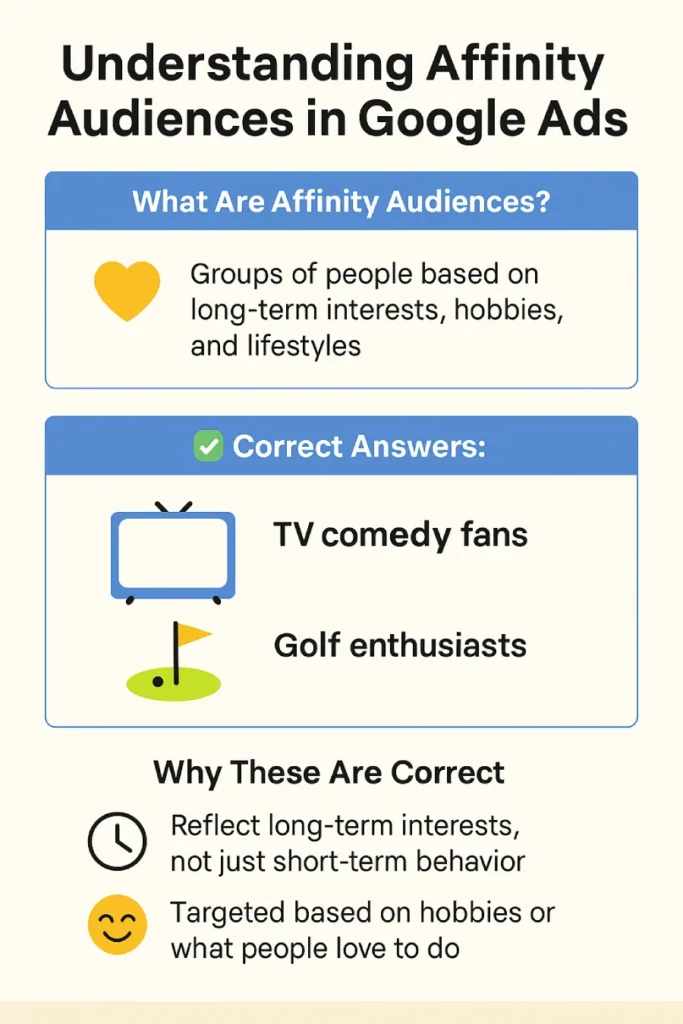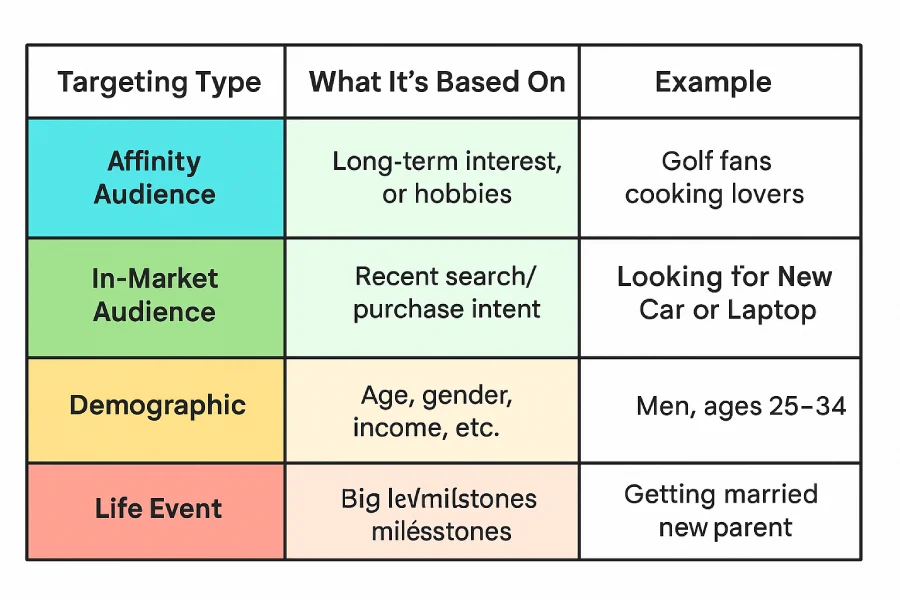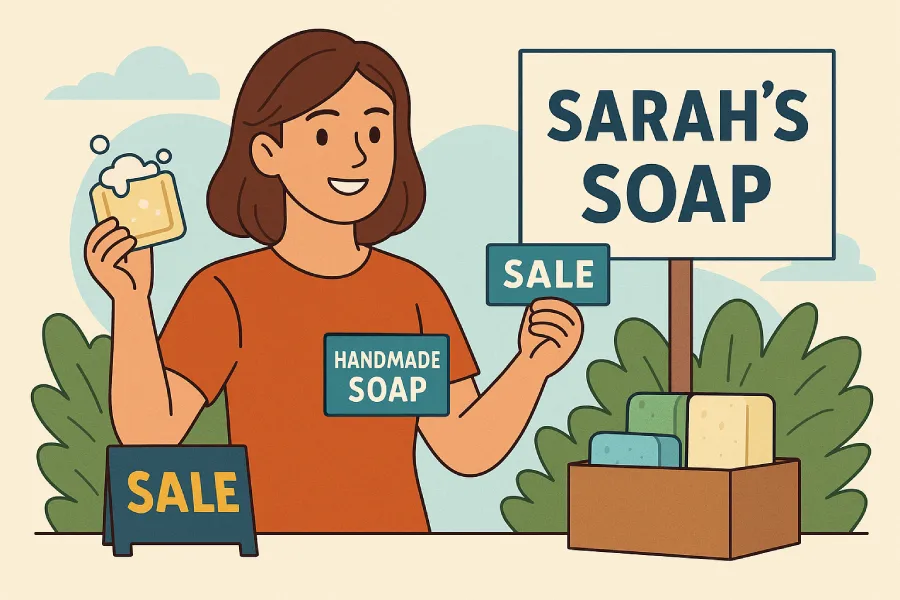I was sitting at home, halfway through my Google Ads study, when I read about Emily, a small business owner who sells handmade soap. She used Responsive Display Ads with just a few headlines and photos… and boom — her traffic tripled.
That’s when I thought, “Okay, this isn’t just for big brands. This actually works.”
Question
What are two examples of the types of audiences you could reach when using Affinity Audiences as a targeting option? (Choose two.)
- Men and women, ages 35 to 44
- TV comedy fans
- People looking to buy a car
- Parents of infants
- Golf enthusiasts
Here are two correct answers:
- TV comedy fans
- Golf enthusiasts
Why These Are Correct
🧩 What are Affinity Audiences?
Affinity Audiences are groups of people who already have a strong, ongoing interest or lifestyle affinity with a specific topic — like comedy shows, golf, vegan food, or fashion.
It’s not about what someone is shopping for right now. It’s about their long-term passions, the kind of stuff they read, watch, or talk about all the time.
✅ TV Comedy Fans
This is a textbook example of an Affinity Audience. These people spend lots of time watching sitcoms, stand-up, and funny clips — Google tracks those signals.
✅ Golf Enthusiasts
Another perfect fit. If someone’s browsing golf blogs, buying clubs, and watching tournament highlights regularly, that interest places them squarely in an Affinity Audience.
Why the Other Options Are Incorrect
❌ 1. Men and women, ages 35 to 44
This is demographic targeting, not Affinity. You’re targeting based on age/gender — not lifestyle or passion.
Key point: Affinity = what people love. Demographic = who people are.
❌ 2. People looking to buy a car
This is an In-Market Audience. These users are actively searching for something to buy now — not long-term interest.
Key difference: In-Market = short-term buying behavior. Affinity = long-term interest.
❌ 3. Parents of infants
This is Life Events or Custom Segment targeting. Parenting is a life stage, not a lifestyle passion.
Example: Someone might be a new parent today, but not forever. It’s not a passion like comedy or golf.

Chart: Audience Type Breakdown
| Targeting Type | Based On | Examples |
|---|---|---|
| Affinity Audience | Lifestyle/long-term passion | Golf, TV shows, cooking |
| In-Market Audience | Purchase behavior | Looking to buy a car/laptop |
| Demographic | Age, gender, income, etc. | Men ages 35–44 |
| Life Events | Life milestones | New parents, recent movers |

Real-Life Example: Sarah the Soap Seller
Sarah owns a small soap business. She wants to advertise to people who consistently care about skin care, eco-living, and handmade goods.
What she uses:
- Affinity Audiences like “Natural Beauty Enthusiasts” and “Green Living Fans.”
She’s not targeting people buying soap today — she’s targeting people who deeply care about her niche, even if they’re not ready to buy right now.

Helpful Resources
- Google Ads: Affinity Audiences Overview
- Think with Google – Targeting Insights
- Skillshop: Display Ads Certification
- YouTube: Affinity vs In-Market Audiences
- Google Ads Audience Targeting Guide
Conclusion
Affinity Audiences help you reach people who already have a deep connection with your product type.
You’re not targeting someone just because they’re 35 or shopping for something right now. You’re reaching people who say, “I love this topic,” day in and day out.
In this case:
- ✅ TV Comedy Fans = long-term entertainment lovers
- ✅ Golf Enthusiasts = lifestyle-driven hobbyists
If you want loyal eyeballs, Affinity is where you go.
Now, if you are ready, you can take the Google Skillshop test for the Google Ads Display Exam. Want more real exam questions with easy answers like this? Follow along — I’ll be breaking down more Google Ads Display Measurement Certification Free examples in the next posts!
FAQs
1. What’s the main benefit of using Affinity Audiences?
They help build long-term brand awareness by connecting with people who truly care about your topic.
2. Are Affinity Audiences good for conversions?
Mostly for awareness, but if your brand fits the lifestyle, they can work long-term.
3. Can I combine Affinity with other targeting types?
Yes! Combine with demographics, locations, or even keywords for smarter targeting.
4. What’s the difference between Affinity and In-Market?
Affinity = who you are. In-Market = what you’re shopping for.
5. Are Affinity audiences predefined?
Yes, Google has 100+ built-in. But you can also create Custom Affinity Audiences with keywords and URLs.
6. Where do Affinity Ads show?
Across the Google Display Network, Gmail, and YouTube.
7. Can I use them for remarketing?
Not directly, but you can layer audiences for smart retargeting.
8. Are there Affinity categories for pets, food, sports, etc.?
Absolutely! Categories include travel, gaming, TV genres, home decor, and more.
9. What’s an example of a fun Affinity Audience?
Try “Pet Lovers” — it works great for dog or cat product ads!
10. Do I need a big budget to use Affinity targeting?
No — it works with small daily budgets just like other targeting options.

